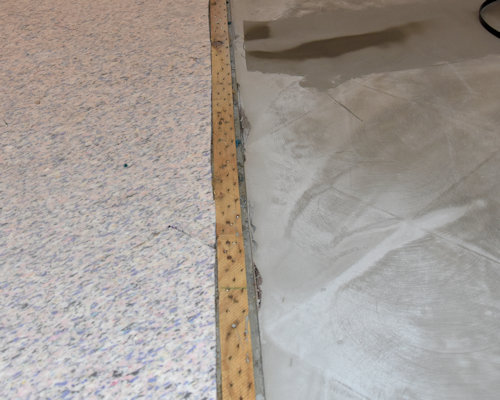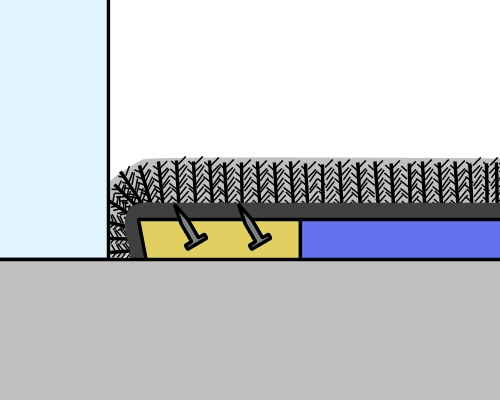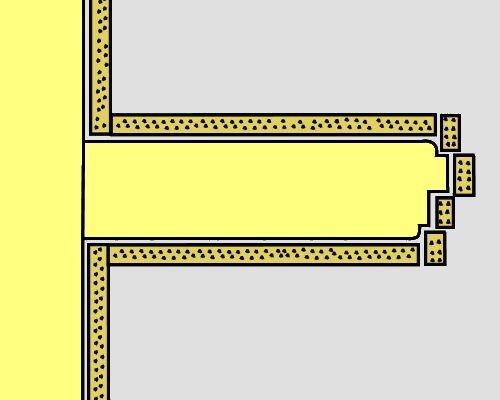Installing carpet grippers
 Audio for slide 1 (mp3 |6|KB)
Audio for slide 1 (mp3 |6|KB)
Adhesive-fixed carpet installations often don't use gripper strips.
However, grippers can be used to achieve a smooth-edge appearance around the walls.
They also tend to be used on woven wool carpets that need to be periodically steam cleaned, such as in clubs and hotels, in order to reduce shrinkage problems.

 Audio for slide 2 (mp3 |6|KB)
Audio for slide 2 (mp3 |6|KB)
You may have already been laying carpet over a cushion underlay in domestic applications, using domestic gripper strips to secure the carpet around the perimeter of the rooms.
The principles are the same when you're installing dual bond carpets, except now you're more likely to be working in commercial premises, rather than people's homes.
This means that you should use commercial carpet gripper, with three rows of pins, rather than domestic gripper, which only has two rows.
Below is a review of the installation procedures for grippers.

 Audio for slide 3 (mp3 |6|KB)
Audio for slide 3 (mp3 |6|KB)
Fixing to the subfloor
Most grippers have steel nails positioned at regular intervals along the length of the plywood. When you put the gripper in position on the floor, you can then simply hammer the nails in to secure the strip.
There are different types of nails used for different subfloor materials:
- ring shank nails are designed for timber or plywood subfloors
- smooth shank nails are designed for higher density (harder) concrete subfloors
- spiral shank nails are for lower density concrete, which tends to crumble more around the nail hole.

 Audio for slide 4 (mp3 |6|KB)
Audio for slide 4 (mp3 |6|KB)
In this case, the gripper strip can be fixed to the floor surface using contact or construction adhesive.
For surfaces such as ceramic tiles, it can be fixed using plugs and screws.
If the subfloor is metal, you can use self-tapping screws.

 Audio for slide 5 (mp3 |6|KB)
Audio for slide 5 (mp3 |6|KB)
The gully
The gripper strip has an undercut bevel on one side which is placed facing the wall.
This gives you a space, or gully, to tuck the edge of the carpet into.
The width of the gully should be about 60% of the thickness of the carpet.
Don't make the gully too wide, because that will cause the carpet to droop at the edge.
On the other hand, don't make the gully too narrow, because then you won't be able to tuck in the edge of the carpet.
If you try to wedge or force the carpet into position, you might end up cracking the skirting board.

 Audio for slide 6 (mp3 |6|KB)
Audio for slide 6 (mp3 |6|KB)
Calculating quantities
The most obvious way to calculate the amount of gripper strip needed for an installation is to measure around the perimeter walls, not including doorways and other openings (unless the carpet is butting up against a different floor covering).
However, carpet layers sometimes use a simple rule of thumb to estimate the quantity needed:
For commercial installations: allow 0.65 lineal metres for every square metre of carpet.


Learning activity
Audio 7 (mp3 |6|KB)Do a measure up of the room you're in right now (or a nearby room) and estimate the quantity of gripper strip needed for the installation.
Use both techniques described above - measuring the perimeter of the area and using the rule of thumb for commercial installations.
Compare the two results.
Refer to the unit Making measurements if you need more information on the calculation techniques.





